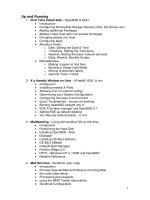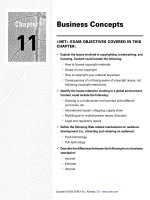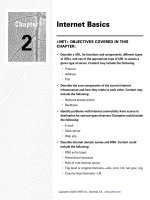Tài liệu Autonomic Networking pdf
Bạn đang xem bản rút gọn của tài liệu. Xem và tải ngay bản đầy đủ của tài liệu tại đây (85.69 KB, 5 trang )
Autonomic Networking
Some numbers
40% of the problems in the
services are the configuration
inside the operator,
20-50% of the time is for find
and solving the problems,
The critical problems cost
$2.8M per hour,
4/5 $ are used for the maintain
and the small ameliorations.
Needs for an autonomic
approach
Traditional Management :
The human (user) on the core of the reaction loop.
The compartmental and information models are static.
The architectures and the process are ad hoc.
The new technology complexity need a lot of capacity for
the processing in we compare with the human's capacities.
Challenges
Distributed decisions.
Knowledge rather than the data.
Automatic adaptation for the system and the different
contexts.
Security and protection.
Autonomous Network
Definition
The main idea is an autonomous network
development. It must be follow a the capacity of the
self-organization same the biologic systems.
The system must be considerate same an natural
group of entities, self-controlled. For theirs goals they
don't need the external intervention
All the entities can be integrate others self-controlled
entities and again …
The recursive self-controlled concept are in different
domains of the society, the economy, and principally
in the biology, etc.
The kernel for the
autonomous systems
In the management level, the goal is the simplification.
We want hide from the administrator the control details
inside the components (software and hardware) for an
autonomous system.
The autonomous systems maintain and adapt their
comportment function of :
Internal modifications (components, software),
External modifications (capacity, environment inside the network,
etc.),
The needs or the demands,
The goals,
Software or material problems
(malicious and innocent).
Agreement renegotiations









